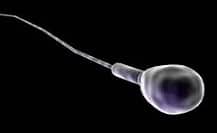 The term spermatozoon , which derives from the French word spermatozoïde , refers to the male gamete. The gamete, for its part, is the sexual cell , whether male (the aforementioned sperm) or female (the egg ).
The term spermatozoon , which derives from the French word spermatozoïde , refers to the male gamete. The gamete, for its part, is the sexual cell , whether male (the aforementioned sperm) or female (the egg ).
When the sperm and egg join, the zygote is formed. As the zygote develops, the various stages begin to occur that later lead to the birth of a new being.
The process of sperm production, which takes place in the testicles (the male sexual glands), is known as spermatogenesis . In the case of humans, when a young person reaches sexual maturity at puberty , they begin to generate sperm and are biologically prepared for reproduction .
Sperm cells have a head and a tail known as a flagellum that allows them to move. Its expulsion from the body occurs through ejaculation , which can be produced by nocturnal pollution, masturbation or sexual intercourse. With ejaculation, sperm come out through the urethra , a tube found in the penis .
In this way, when a man penetrates a woman through the vagina and ejaculates inside her, the sperm can fertilize the eggs: if this occurs, the woman becomes pregnant .
It should be noted that the fluid expelled during ejaculation is known as semen and contains, in addition to millions of sperm, other substances produced by the sexual apparatus. Human beings usually expel between two and four milliliters of semen in ejaculation, which contain between sixty and three hundred million sperm.
Medicine has tests to evaluate the quality of semen, something very important in cases of difficulty achieving a pregnancy . One of the possible results of this procedure is known as low sperm count , and this is an insufficient number of sperm in the semen. Another name for this condition is oligospermia , while the complete absence of sperm is called azoospermia .
The number of sperm needed for the count to be considered low is less than 15,000,000 per milliliter of semen sample . Needless to say, given a result like this, the chances of a sperm fertilizing an egg are below normal; However, many men achieve fatherhood despite this.
Since it is not a disease or problem that causes obvious symptoms , many men detect low sperm count only after several failed attempts to have children. Sometimes there are underlying disorders, such as a hormonal imbalance, a disease that prevents the normal circulation of semen, a hereditary abnormality in the chromosomes or a dilation of the veins of the testicles, and this can arouse the doctor's suspicions and prompt him to Examine your patient's semen.
 There are many factors that can negatively influence sperm production, as well as their effectiveness in fertilizing an egg, and many of them are found in the individual's environment, such as the following:
There are many factors that can negatively influence sperm production, as well as their effectiveness in fertilizing an egg, and many of them are found in the individual's environment, such as the following:
* exposure to certain heavy metals : one of the most common causes of sterility is exposure to heavy metals such as lead;
* exposure to certain substances : in this group we have organic solvents, pesticides, xylene, toluene, benzenes and certain paint materials ;
* radiation : among the various harms that radiation can bring us is the decrease in sperm. Once the individual is no longer exposed to it, it can take many years to recover normal semen production;
* excess heat : if a man subjects his testicles to high temperatures frequently, he risks negatively affecting sperm production.
